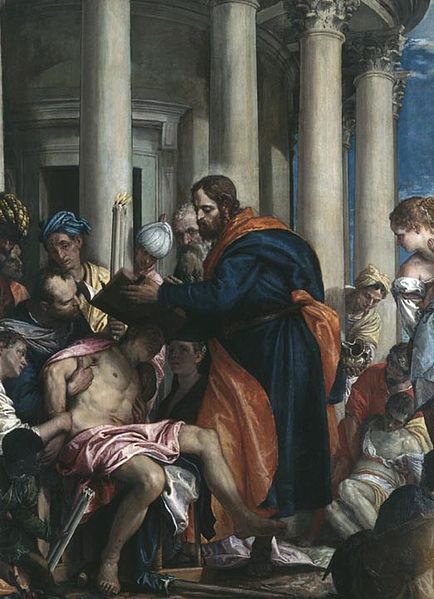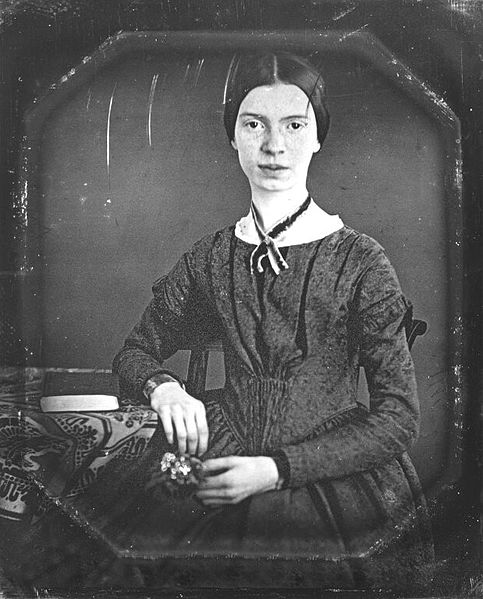Misyon Online - May-June 2013
Pulong ng Editor
A seminarian on ‘KP’ for two years in the South Korean Army
By Jehoon Augustine Lee
The author is a Columban seminarian from the Republic of Korea on First Mission Assignment in Quezon City. Here he tells us about his mandatory two-year military service when he was already a seminarian, nearly all of which he spent in the very unglamorous ‘Kitchen Patrol’ or ‘KP’.
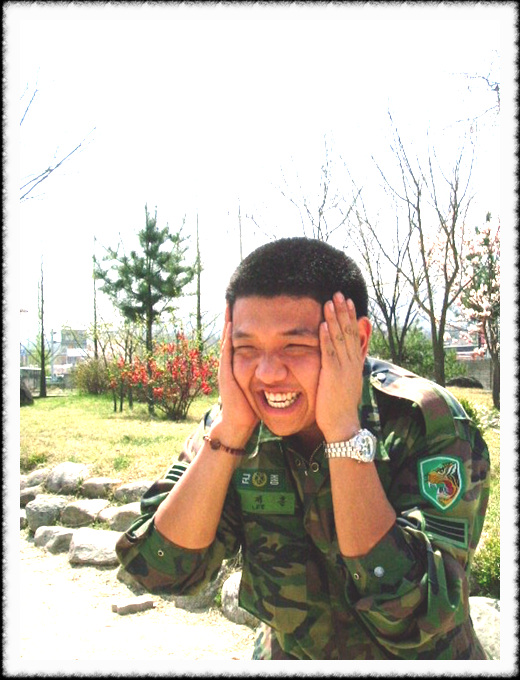
In my native country, South Korea, all males between the ages of 18 and 35 who are physically and mentally able are mandated by Korean law to perform two years of military service. Koreans require this military service as a part of their national duty; there is a perceived need to share in national defense as well as prepare for potential war with North Korea.
A Visit to Tepeyac, Mexico
By Vissia Hernandez
We celebrate the feast of Our Lady of Guadalupe, the secondary Patroness of the Philippines and Protectress of Unborn Children, on December 12. Tepeyac, or the Hill of Tepeyac, Mexico, is where the Blessed Virgin appeared to San Juan Diego in 1531. The shrine of Nuestra Señora de Guadalupe, Our Lady of Guadalupe, is one of the most visited in the world. Vissia Hernandez has written previously for Misyon.
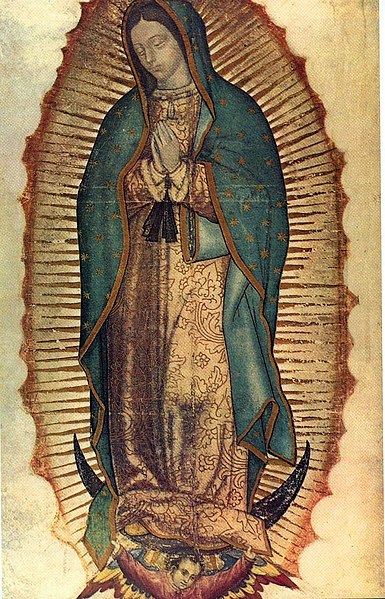
‘It’s like Baclaran’,was my first impression, as I got off the city bus. Stores and stalls selling everything from recuerdos y zapatos (souvenirs and shoes) to comidas y bebidas (food and drink) line both sides of a pedestrian area leading to La Villa (‘the town’, referring to the Basilica compound). A brisk five-minute walk away, behind a tall fence, towers an ancient brick church – the old Basilica, with its imposing yellow dome, twin bell-towers and ornate facade.
As more and more people were streaming towards the gates, I qualified my first impression, ‘It’s like Baclaran on a first Wednesday!’ Excitement mounted with each step until I finally reached the gates of La Villa. Inside, folk dancers with tall headdresses and fierce masks were performing a ritual dance. As I surveyed the wide expanse of Plaza Mariana with its many churches and chapels, a baptistery and a small hill, I was reminded of the Marian shrine complexes in Lourdes and Fatima, only this time, the hordes of pilgrims were predominantly Mexican, and the atmosphere familiarly ‘fiesta’. People were carrying around big and small images, even altars and carrozas of their beloved patroness, reminiscent of Filipino devotees cradling treasured Sto Niños in their arms during the January processions. Instantly, I felt at home!
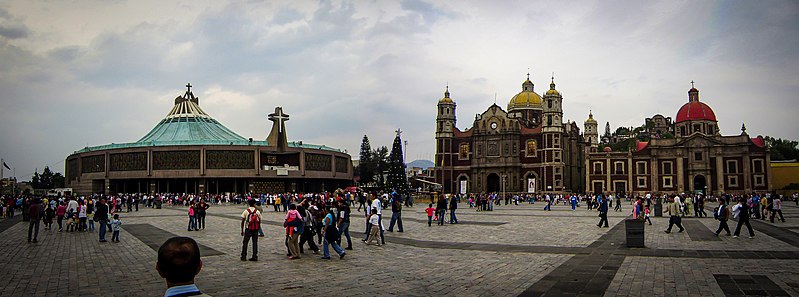
Plaza Mariana with the New Basilica, the Old Basilica and the Temple of the Capuchin Nuns
The moment we have been waiting for
by Fr Dan Harding
The author is an Australian Columban who worked in Chile for many years. He is now editor of The Far East, the Columban magazine in Australia and New Zealand.

On 4 June 1770 Captain Cook sailed into a passage through the Great Barrier Reef that was surrounded by beautiful continental islands. He was on his historic voyage of discovery up the east coast of Australia. These islands and the sea passage were named the Whitsunday Islands and Passage after the liturgical celebration of the day, Whitsunday (also known as ‘Whitsunday’ or ‘Whitsun’). Actually Cook had miscalculated his date and it was really the following day, Whit Monday.

Hill Inlet, Whitsunday Islanda the largest of the Whitsunday Islands
What is this liturgical celebration called Whitsunday? It is another name for the second most important day after Easter in the Church’s liturgical calendar - the great Solemnity of Pentecost. The name Whitsunday comes from White Sunday when in Medieval times, those who had been baptized seven weeks earlier at Easter donned again their white baptismal robes. Some baptisms also took place at this time.
Angels in a Jungle in PakistanBy Fr Paul McMahon The author is a Columban priest from Belfast, Northern Ireland, and tells the story of ‘Angels’ from northern Pakistan, Muslims students, helped a wedding party of Catholics on a night-time journey through a jungle. The article is taken from the December 2012 Newsletter of the Pakistan Mission Unit of the Columbans.
Mr William Raza has been the assistant to the House-in-Charge at the Columban House in Lahore for the last 25 years. Recently he and his extended family formed a wedding party to travel from Lahore with his nephew who was to get married in Karachi. The journey of 1400 kilometers was to bring unexpected adventures and lessons on how God provides angels along the way to look after us. Even in the least expected places!
Angels in JapanBy Fr Joseph Joyce After almost 35 years of priestly ministry, I was given the precious privilege of a sabbatical year. To make best use of the time, I decided that, inst On this pilgrimage, I resolved to do three things. Firstly, I would adopt a ‘contemplative attitude’, opening myself as much as possible to every thing and every one, and letting myself be impacted by what I encountered. Secondly, I would ‘read’ my experiences, reflecting each evening on my encounters with people and life as I found them. And thirdly, I would try to discern from it all how God might be guiding me for the future. Thus, I set out on a journey that took me to Hong Kong, Mainland China, Taiwan, Korea, and Japan. As I travelled through the various countries, I had, of course, many interesting experiences, but one of the most outstanding occurred in Japan.
|

May-June 2013

The Veil of Veronica, El Greco, 1580-82 (Web Gallery of Art)
For the Lord is righteous; he loves justice. The upright will see his face.
~ Psalm11:7 (Christian Community Bible) ~
+++
|
|
|---|
The poverty that Jesus means – that the prophets mean – presupposes above all inner freedom from the greed for possession and the mania for power. This is a greater reality than merely a different distribution of possessions, which would still be in the material domain and thereby make hearts even harder. It is first and foremost a matter of purification of heart, through which one recognizes possession as responsibility, as a duty towards others, placing oneself under God's gaze and letting oneself be guided by Christ, who from being rich became poor for our sake (cf. 2 Cor 8: 9). Inner freedom is the prerequisite for overcoming the corruption and greed that devastate the world today. This freedom can only be found if God becomes our richness; it can only be found in the patience of daily sacrifices, in which, as it were, true freedom develops. It is the King who points out to us the way to this goal: Jesus, whom we acclaim on Palm Sunday, whom we ask to take us with him on his way.
~Pope Benedict XVI, Homily on Palm Sunday, 9 April 2006, St Peter’s Square, Vatican City, 21st World Youth Day.
+++

Is blessing objects exclusive to priests?
I wanted to know more about holy water because tomorrow is Easter Sunday and I want to teach my little children why we're getting holy water from the church for our home.
Father Seán, if I have strong faith in God and believe in the power of holy water, and I have newly-bought candles and rosaries at home that are not blessed, can I bless them with the holy water myself? Or is it only priests who have the power to bless candles and other religious objects?
In line with the article here, cyber blessing is the newest way of blessing others just like what you're doing here, Father Seán! I do so too on my own blog! Isn't it just great, Fatherr! To be able to bless strangers on the net, with words and teachings of the Lord and of His church!
May the Father bless you, your family and your sheep a thousand-fold, Father Seán!
Pulong ng Editor
A Visit to Tepeyac, Mexico
By Vissia Hernandez
We celebrate the feast of Our Lady of Guadalupe, the secondary Patroness of the Philippines and Protectress of Unborn Children, on December 12. Tepeyac, or the Hill of Tepeyac, Mexico, is where the Blessed Virgin appeared to San Juan Diego in 1531. The shrine of Nuestra Señora de Guadalupe, Our Lady of Guadalupe, is one of the most visited in the world. Vissia Hernandez has written previously for Misyon.
|
|
|---|
‘It’s like Baclaran’, was my first impression, as I got off the city bus. Stores and stalls selling everything from recuerdos y zapatos (souvenirs and shoes) to comidas y bebidas (food and drink) line both sides of a pedestrian area leading to La Villa (‘the town’, referring to the Basilica compound). A brisk five-minute walk away, behind a tall fence, towers an ancient brick church – the old Basilica, with its imposing yellow dome, twin bell-towers and ornate facade.
As more and more people were streaming towards the gates, I qualified my first impression, ‘It’s like Baclaran on a first Wednesday!’ Excitement mounted with each step until I finally reached the gates of La Villa. Inside, folk dancers with tall headdresses and fierce masks were performing a ritual dance. As I surveyed the wide expanse of Plaza Mariana with its many churches and chapels, a baptistery and a small hill, I was reminded of the Marian shrine complexes in Lourdes and Fatima, only this time, the hordes of pilgrims were predominantly Mexican, and the atmosphere familiarly ‘fiesta’. People were carrying around big and small images, even altars and carrozas of their beloved patroness, reminiscent of Filipino devotees cradling treasured Sto Niños in their arms during the January processions. Instantly, I felt at home!

Plaza Mariana with the New Basilica, the Old Basilica and the Temple of the Capuchin Nuns
|
|
|---|
|
|
|---|
As I turned around, there it was, the new Basilica of Our Lady of Guadalupe! My eyes were immediately drawn to the large Spanish inscription above the main door ‘No Estoy Yo Aqui, Que Soy tu Madre?’ (Am I, who is your Mother, not here?)
Misty-eyed, I whispered in gratitude, ‘Mama Maria, your peregrina (pilgrim) is finally here, a week late, but as promised, estoy aqui!’ I hurried into the ‘new’ Basilica shaped like a ‘giant's salakot [2], and was astounded for inside it was huge, cavernous, yet packed to its ‘SRO’ capacity of about 10,000. In a prominent place of honor above the altar, hangs San Juan Diego’s famous tilma (mantle) miraculously preserved through the centuries with its imprint of the Blessed Mother’s image (her only known photograph – developed in color in some celestial darkroom).
Thanks to my phone’s missal app, and remnants of college Spanish, I managed to participate in the lauds and Masses, and even joined in the rousing cheers of ‘Viva El Cristo Rey, Viva Nuestra Señora de Guadalupe, Viva!’ which reverberated throughout La Villa that day. It was the Feast of Christ the King. I later learned that this very Feast was established in 1925 by Pope Pius XI, to fight anticlericalism in Mexico which soon escalated to outright anti-Catholicism triggering the massive rebellion led by the Cristeros. From 1926-1929, tens of thousands were tortured and killed for the Faith, including the 25 Mexican Martyrs canonized in 2000 by Pope John Paul II. ‘Viva El Cristo Rey, Viva Nuestra Señora de Guadalupe!’ was their battle cry, then and now, fiery and full-bodied like their tequila. How providential that I was delayed for a week, or I would have missed all this.
|
Las Manañitas a La Virgen, 12 December 2012, sung in the Basilica after the early morning Mass. Las Mañanitas is a traditional Mexican birthday song, also known in the Philippines, sung to the celebrant very early in the morning. |
|---|
I spent the rest of the day praying and meditating in the many churches and chapels of La Villa de Guadalupe, gazing awestruck at the beloved image on the tilma while standing on walkalators hidden beneath the new Basilica’s sanctuary, and on the side, shopping for recuerdos, taking gigabytes of pictures, and finally, huffing and puffing my way to the top of Tepeyac Hill where a small church stands where the Blessed Virgin first appeared in 1531 to the peasant, Juan Diego. By sundown, while taking in the magnificent view of the Basilicas of Guadalupe, this tired yet extremely blissful peregrina couldn’t thank her gracious Hosts enough for the sense of peace, joy and love which had enfolded her like a tilma throughout her pilgrimage. ¡Gracias, El Cristo Rey. Gracias, Madre mía de Guadalupe!
‘Hear me and understand well that nothing should frighten or grieve you. Let not your heart be disturbed. Do not fear that sickness, nor any other sickness or anguish. Am I not here, who is your Mother? Are you not under my protection? Am I not your health? Are you not happily within my fold? What else do you wish? Do not grieve nor be disturbed by anything.’
-- Message of Our Lady of Guadalupe
|
Himno a la Humildad, sung by Marco Antonio Solís: Con que gusto venimos con gran emoción How we love to come with great feeling Beloved Virgin . . . miraculous, Dark Virgin, Queen of hope, (Spoken) We come here, beloved Mother, with our bodies more tired that the last time, Virgencita adorada, no me puedo ir Dear Blessed Virgin, I cannot leave Dark Virgin, Queen of hope, [Thanks to Fr Jovito Dales for help with the translation.] |
|---|
You may email the author at Vissia_Hernandez@pal.com.ph
A seminarian on ‘KP’ for two years in the South Korean Army
Pulong ng Editor
A seminarian on ‘KP’ for two years in the South Korean Army
By Jehoon Augustine Lee
The author is a Columban seminarian from the Republic of Korea on First Mission Assignment in Quezon City. Here he tells us about his mandatory two-year military service when he was already a seminarian, nearly all of which he spent in the very unglamorous ‘Kitchen Patrol’ or ‘KP’.

In my native country, South Korea, all males between the ages of 18 and 35 who are physically and mentally able are mandated by Korean law to perform two years of military service. Koreans require this military service as a part of their national duty; there is a perceived need to share in national defense as well as prepare for potential war with North Korea.
As a Korean man, I served two years in the Korean military service from 2001 to 2003. Although I had already joined the Columban Fathers, I had no choice; service was mandatory. I was able to first complete my philosophy studies, but immediately after finishing these, I was called to begin my service. My feelings on this were very mixed. I certainly was willing and enthusiastic about performing my national duty as a Korean man and a Korean citizen; on the other hand, I had just been accepted to join the Columban Fathers and was excited to begin my vocational journey. A lot of my uncertainty was because I knew that my military service would be a huge time obligation – I wasn’t sure how I would be able to attend Mass, prayer services, and find the time to peacefully discern my vocation as a seminarian.
A Visit to Tepeyac, Mexico
By Vissia Hernandez
We celebrate the feast of Our Lady of Guadalupe, the secondary Patroness of the Philippines and Protectress of Unborn Children, on December 12. Tepeyac, or the Hill of Tepeyac, Mexico, is where the Blessed Virgin appeared to San Juan Diego in 1531. The shrine of Nuestra Señora de Guadalupe, Our Lady of Guadalupe, is one of the most visited in the world. Vissia Hernandez has written previously for Misyon.
‘It’s like Baclaran’,was my first impression, as I got off the city bus. Stores and stalls selling everything from recuerdos y zapatos (souvenirs and shoes) to comidas y bebidas (food and drink) line both sides of a pedestrian area leading to La Villa (‘the town’, referring to the Basilica compound). A brisk five-minute walk away, behind a tall fence, towers an ancient brick church – the old Basilica, with its imposing yellow dome, twin bell-towers and ornate facade.
As more and more people were streaming towards the gates, I qualified my first impression, ‘It’s like Baclaran on a first Wednesday!’ Excitement mounted with each step until I finally reached the gates of La Villa. Inside, folk dancers with tall headdresses and fierce masks were performing a ritual dance. As I surveyed the wide expanse of Plaza Mariana with its many churches and chapels, a baptistery and a small hill, I was reminded of the Marian shrine complexes in Lourdes and Fatima, only this time, the hordes of pilgrims were predominantly Mexican, and the atmosphere familiarly ‘fiesta’. People were carrying around big and small images, even altars and carrozas of their beloved patroness, reminiscent of Filipino devotees cradling treasured Sto Niños in their arms during the January processions. Instantly, I felt at home!

Plaza Mariana with the New Basilica, the Old Basilica and the Temple of the Capuchin Nuns
The moment we have been waiting for
by Fr Dan Harding
The author is an Australian Columban who worked in Chile for many years. He is now editor of The Far East, the Columban magazine in Australia and New Zealand.

On 4 June 1770 Captain Cook sailed into a passage through the Great Barrier Reef that was surrounded by beautiful continental islands. He was on his historic voyage of discovery up the east coast of Australia. These islands and the sea passage were named the Whitsunday Islands and Passage after the liturgical celebration of the day, Whitsunday (also known as ‘Whitsunday’ or ‘Whitsun’). Actually Cook had miscalculated his date and it was really the following day, Whit Monday.

Hill Inlet, Whitsunday Islanda the largest of the Whitsunday Islands
What is this liturgical celebration called Whitsunday? It is another name for the second most important day after Easter in the Church’s liturgical calendar - the great Solemnity of Pentecost. The name Whitsunday comes from White Sunday when in Medieval times, those who had been baptized seven weeks earlier at Easter donned again their white baptismal robes. Some baptisms also took place at this time.
Angels in a Jungle in PakistanBy Fr Paul McMahon The author is a Columban priest from Belfast, Northern Ireland, and tells the story of ‘Angels’ from northern Pakistan, Muslims students, helped a wedding party of Catholics on a night-time journey through a jungle. The article is taken from the December 2012 Newsletter of the Pakistan Mission Unit of the Columbans.
Mr William Raza has been the assistant to the House-in-Charge at the Columban House in Lahore for the last 25 years. Recently he and his extended family formed a wedding party to travel from Lahore with his nephew who was to get married in Karachi. The journey of 1400 kilometers was to bring unexpected adventures and lessons on how God provides angels along the way to look after us. Even in the least expected places!
Angels in JapanBy Fr Joseph Joyce After almost 35 years of priestly ministry, I was given the precious privilege of a sabbatical year. To make best use of the time, I decided that, inst On this pilgrimage, I resolved to do three things. Firstly, I would adopt a ‘contemplative attitude’, opening myself as much as possible to every thing and every one, and letting myself be impacted by what I encountered. Secondly, I would ‘read’ my experiences, reflecting each evening on my encounters with people and life as I found them. And thirdly, I would try to discern from it all how God might be guiding me for the future. Thus, I set out on a journey that took me to Hong Kong, Mainland China, Taiwan, Korea, and Japan. As I travelled through the various countries, I had, of course, many interesting experiences, but one of the most outstanding occurred in Japan.
|

May-June 2013

The Veil of Veronica, El Greco, 1580-82 (Web Gallery of Art)
For the Lord is righteous; he loves justice. The upright will see his face.
~ Psalm11:7 (Christian Community Bible) ~
+++
|
|
|---|
The poverty that Jesus means – that the prophets mean – presupposes above all inner freedom from the greed for possession and the mania for power. This is a greater reality than merely a different distribution of possessions, which would still be in the material domain and thereby make hearts even harder. It is first and foremost a matter of purification of heart, through which one recognizes possession as responsibility, as a duty towards others, placing oneself under God's gaze and letting oneself be guided by Christ, who from being rich became poor for our sake (cf. 2 Cor 8: 9). Inner freedom is the prerequisite for overcoming the corruption and greed that devastate the world today. This freedom can only be found if God becomes our richness; it can only be found in the patience of daily sacrifices, in which, as it were, true freedom develops. It is the King who points out to us the way to this goal: Jesus, whom we acclaim on Palm Sunday, whom we ask to take us with him on his way.
~Pope Benedict XVI, Homily on Palm Sunday, 9 April 2006, St Peter’s Square, Vatican City, 21st World Youth Day.
+++

Is blessing objects exclusive to priests?
I wanted to know more about holy water because tomorrow is Easter Sunday and I want to teach my little children why we're getting holy water from the church for our home.
Father Seán, if I have strong faith in God and believe in the power of holy water, and I have newly-bought candles and rosaries at home that are not blessed, can I bless them with the holy water myself? Or is it only priests who have the power to bless candles and other religious objects?
In line with the article here, cyber blessing is the newest way of blessing others just like what you're doing here, Father Seán! I do so too on my own blog! Isn't it just great, Fatherr! To be able to bless strangers on the net, with words and teachings of the Lord and of His church!
May the Father bless you, your family and your sheep a thousand-fold, Father Seán!
The moment we have been waiting for
by Fr Dan Harding
The author is an Australian Columban who worked in Chile for many years. He is now editor of The Far East, the Columban magazine in Australia and New Zealand.

On 4 June 1770 Captain Cook sailed into a passage through the Great Barrier Reef that was surrounded by beautiful continental islands. He was on his historic voyage of discovery up the east coast of Australia. These islands and the sea passage were named the Whitsunday Islands and Passage after the liturgical celebration of the day, Whitsunday (also known as ‘Whitsunday’ or ‘Whitsun’). Actually Cook had miscalculated his date and it was really the following day, Whit Monday.

Hill Inlet, Whitsunday Islanda the largest of the Whitsunday Islands
What is this liturgical celebration called Whitsunday? It is another name for the second most important day after Easter in the Church’s liturgical calendar - the great Solemnity of Pentecost. The name Whitsunday comes from White Sunday when in Medieval times, those who had been baptized seven weeks earlier at Easter donned again their white baptismal robes. Some baptisms also took place at this time.
|
|
|---|
At Pentecost, the Holy Spirit descended upon the disciples and Mary the Mother of Jesus who were waiting in prayer in the Cenacle, the Upper Room, for the arrival of the Holy Spirit. It was here in this Upper Room that the Last Supper had taken place and the Risen Lord had also appeared to his disciples. At one of his appearances, he told them not to leave Jerusalem but to wait there for the coming of the Holy Spirit.
To understand what waiting for the arrival of the Holy Spirit at Pentecost is all about, I feel it is really important for us to try to get a sense of what it was like to be in the Cenacle with Mary and with the disciples waiting in prayer for the arrival of the Holy Spirit. What was it like waiting with such anticipation, with bated breath? Were their feelings of excitement, of joyful expectation, of patience and faith mixed perhaps with some doubt, some fear, or feelings of personal inadequacy and unworthiness? Now that the Risen Lord had ascended into heaven, how were they, the disciples to go on? Yet, in a very real sense, they had been waiting for that Pentecostal moment all their lives. Waiting to receive the Spirit of the Risen Lord and be transformed and empowered. Something big was about to happen, something very big. Could they sense Him coming? Could they feel it in the air?
Something of this tremendous sense of excitement, of anticipation and of prayerful waiting is captured in the celebrations of Pentecost Vigils on the night before Pentecost Sunday. In Chile where I served many years as a Columban Missionary Priest, almost all parishes organize annual Pentecost Vigils for the youth and other interested parishioners. These Vigils begin after the Saturday night Vigil Eucharist in the parish church and usually continue all night until the Sunday Eucharist of Pentecost the following day.
‘Come, Holy Spirit’, Vigil of Pentecost, Parish of San Pedro Nolasco, Puente Alto, Chile
The areas where our Columban parishes are located in Chile are areas with a high rate of crime, gangs and substance abuse. This is why it is often necessary to hire off-duty policemen to stand guard during these night vigils. Once the vigils start, the gates of the parish are locked for security reasons and no one is allowed to leave or enter the premises until dawn.
That is no one - except the Holy Spirit - is allowed to enter the parish premises. The Holy Spirit is allowed to enter into the church building and into the hearts and the lives of each vigil participant. During the long and usually cold night hours of the Pentecost Vigil, the participants are invited into a deeper conversion and renewal of their lives through opening their lives, their personal and social reality to the Holy Spirit. This is a moment they have been waiting for.

During the Pentecost Vigil, all are invited to repent of sin and to be forgiven and healed through the Sacrament of Reconciliation which is made available to them. They are invited to a personal encounter with the Risen Lord through the power of the Holy Spirit. The participants sing, pray, dance, move about, hold hands, share their ideas together, pour out their hearts to the Lord and to one another, hug each other, meditate on the Word of God, reflect on the Church’s mission to the world and act out dramatically the events of Pentecost according to the Acts of the Apostles.
Veni Creator Spiritus
Come Creator Spirit
During these long night hours of the vigil, the participants also prepare the parish church with decorations for the celebration of the Eucharist the following morning, Pentecost Sunday. These decorations include banners and posters with different images of the Holy Spirit and the Pentecost event such as the dove, tongues of fire, water associated with the action of the Holy Spirit at baptism, the laying on of hands and anointing with holy oils at confirmation and in other sacraments, the Seven Gifts of the Holy Spirit and the twelve Fruits of the Holy Spirit. As the Church was born at Pentecost, images of the Church are also prepared. These include: a sheep fold; an ark; the Body of Christ; the Heavenly Jerusalem; the New Israel; the People of God; the Spouse of Christ and the Temple of the Holy Spirit.
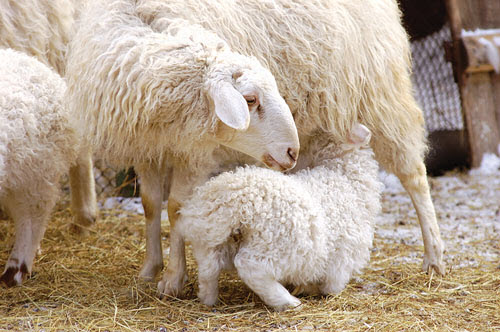
On the day of Pentecost, the Holy Spirit descended upon the disciples and Mary the mother of Jesus gathered in vigil, awaiting His arrival. They first heard the sound of a mighty wind that filled the entire building and then they saw tongues of fire settle upon each person. They were filled with the Holy Spirit and began to speak in different languages.
I have seen with my own eyes moments during the Pentecost Vigils when the Holy Spirit arrives in the lives of the participants and touches, heals and empowers them. Something is awoken in them to empower and transform them and connect them better to the Body of the Risen Lord, the Church and her mission to build up God’s Kingdom. The Pentecost Vigil awakens in the participants a sense of the mission of the Church to ‘renew the face of the Earth’ by bringing the Kingdom of God to the broken, the dispossessed, the poor, the exploited and the excluded. Pentecost is about receiving and being filled, then stepping up and out, going out, diving in, being stretched, taking risks and moving out of one’s comfort zone. It is about fire, about life in the Spirit. Isn’t this what we have always been waiting for all our lives?
Peace by Peace

May-June 2013

The Veil of Veronica, El Greco, 1580-82 (Web Gallery of Art)
For the Lord is righteous; he loves justice. The upright will see his face.
~ Psalm11:7 (Christian Community Bible) ~
+++
|
|
|---|
The poverty that Jesus means – that the prophets mean – presupposes above all inner freedom from the greed for possession and the mania for power. This is a greater reality than merely a different distribution of possessions, which would still be in the material domain and thereby make hearts even harder. It is first and foremost a matter of purification of heart, through which one recognizes possession as responsibility, as a duty towards others, placing oneself under God's gaze and letting oneself be guided by Christ, who from being rich became poor for our sake (cf. 2 Cor 8: 9). Inner freedom is the prerequisite for overcoming the corruption and greed that devastate the world today. This freedom can only be found if God becomes our richness; it can only be found in the patience of daily sacrifices, in which, as it were, true freedom develops. It is the King who points out to us the way to this goal: Jesus, whom we acclaim on Palm Sunday, whom we ask to take us with him on his way.
~Pope Benedict XVI, Homily on Palm Sunday, 9 April 2006, St Peter’s Square, Vatican City, 21st World Youth Day.
+++
We also are men, of like nature with you, and bring you good news, that you should turn from these vain things to a living God who made the heaven and the earth and the sea and all that is in them.~ St Barnabas, Acts of the Apostles 14:15 (RSV Catholic Edition) ~ |
|
|
If I can stop one heart from breaking, ~ Emily Dickinson (1830 – 1886) ~ |

Hermit’s cell, Moville, County Donegal, Ireland
An old monk lived in a small hut in a country infested with robbers. He called it the Home of Peace. One night a robber broke into the hut in search of money. With his dagger drawn, the thief crept toward the monk. The monk was sitting very still, wrapped in deep meditation. Just as the robber got ready to plunge the knife, the old monk opened his eyes. There was absolutely no fear in them. Instead, he looked at the robber with great compassion and tenderness. The robber hesitated, then dropped his dagger and fell to his knees. The old monk rose and put his arms around the would-be-murderer saying, ‘The ways to realize God are not many, but only one – love’.
~ Monastic Tale ~
+++
|
Common of the Blessed Virgin Mary May the venerable intercession of Blessed Mary ever-Virgin
|
|
|
Regina Cæli (Queen of Heaven) |
|
|
Latin text Regina cæli, lætare, alleluia: V. Gaude et lætare, Virgo Maria, alleluia. Oremus. |
English text |
|
|
|
|---|---|
To Search is To Find
Is blessing objects exclusive to priests?

I wanted to know more about holy water because tomorrow is Easter Sunday and I want to teach my little children why we're getting holy water from the church for our home.
Father Seán, if I have strong faith in God and believe in the power of holy water, and I have newly-bought candles and rosaries at home that are not blessed, can I bless them with the holy water myself? Or is it only priests who have the power to bless candles and other religious objects?
In line with the article here, cyber blessing is the newest way of blessing others just like what you're doing here, Father Seán! I do so too on my own blog! Isn't it just great, Fatherr! To be able to bless strangers on the net, with words and teachings of the Lord and of His church!
May the Father bless you, your family and your sheep a thousand-fold, Father Seán!
The blessings you ask about are mostly under the heading of sacramentals. The Catechism of the Catholic Church No 1671 says: Among sacramentals blessings (of persons, meals, objects, and places) come first. Every blessing praises God and prays for his gifts. In Christ, Christians are blessed by God the Father ‘with every spiritual blessing’. This is why the Church imparts blessings by invoking the name of Jesus, usually while making the holy sign of the cross of Christ.
Note that it says 'every blessing praises God'. Normally it is the priest who blesses persons and objects. It is common here in the Philippines in some places for people to approach the priest after Mass, especially on Sunday, to bless various objects or to bless persons. The day after he was elected Pope Francis happened to meet a young married couple in the Basilica of St Mary Major in Rome and, at the request of the husband, blessed his pregnant wife and their unborn child.
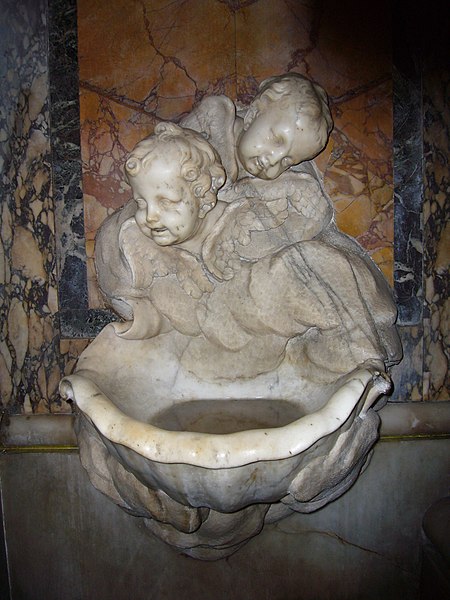 Holy water font, Rome, Italy |
Infant baptism in a Catholic Church You asked specifically about bringing home holy water at Easter. During the Easter Vigil, held after nightfall on Holy Saturday, there is a Baptismal Liturgy when water is blessed. There is one form for blessing the water if baptisms are to take place, another form if not. Both are focused on the water used in baptism. Here is part of the prayer of blessing if there is not baptism, with some words highlighted:
Dear brothers and sisters,
let us humbly beseech the Lord our God
to bless this water he has created,
which will be sprinkled upon us as a memorial of our Baptism.
May he graciously renew us,
that we may remain faithful to the Spirit
whom we have received . . .
Therefore, may this water be for us
a memorial of the Baptism we have received,
and grant that we may share
in the goodness of our brothers and sisters,
who at Easter have received their Baptism.
Through Christ our Lord.
After this prayer the priest leads the people in the renewal of their baptismal promises and then sprinkles them with the newly-bless water. The water that people bring home is essentially to remind them of their baptism.
 French home holy water stoup or font French home holy water stoup or font |
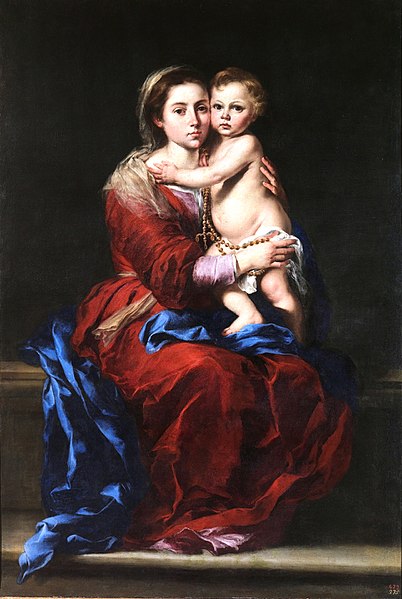
Madonna with Rosary, Murillo, 1650 |
Churches have holy water fonts at their doors and we usually dip the fingers of our right hand into this and then make the Sign of the Cross as we enter.
When your editor was growing up in Ireland most homes, including his, had a small holy water font, not quite as elaborate or large as that in the photo above, at the door of the house and sometimes in bedrooms. When we would leave or enter the house we would bless ourselves with the holy water. We would bring home holy water from a barrel outside the church, the water having been blessed at Easter.
+++
I would suggest that since you have access to your church on a regular basis, you bring the objects you mentioned, rosaries, etc, to the priest and have him bless them.
+++
There are situations where a layperson is authorized to do a blessing, for example, leading a funeral service when no priest is available. This is quite common in p
arishes in the Philippines that are basically rural. When I was parish priest in St Niño Parish, Lianga, Surigao del Sur, nearly 20 years ago, a layman was delegated to lead funeral services if I was away. This would usually be the funeral of a person being buried on the day of death..
It is fitting for parents to bless their children, especially at night. And we can use the word 'blessing' in a broader sense of being a 'blessing' to others through blogs, etc. God can bless individuals in the most extraordinary and unexpected ways in this sense.
But for ritual blessings it is normally the priest who does them, unless others are delegated in certain situations to give such blessings.
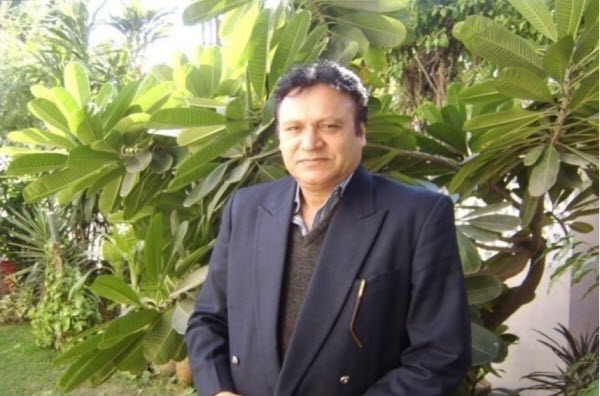
 ead of studying books, I would study people and cultures in some of our Columban mission countries. I would also make the study a kind of pilgrimage.
ead of studying books, I would study people and cultures in some of our Columban mission countries. I would also make the study a kind of pilgrimage.






